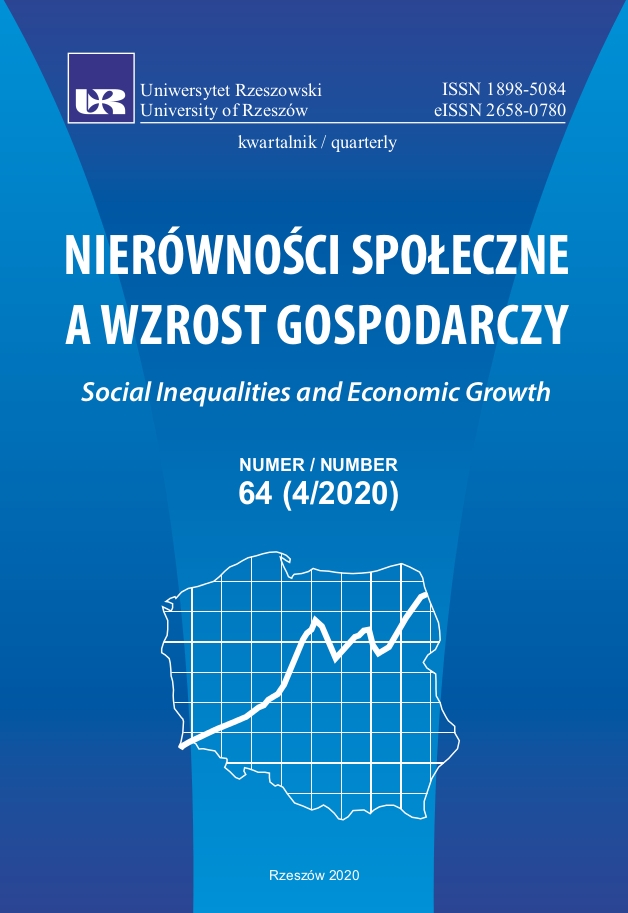Possibilities and restrictions on use of the public-private partnership in the education sector in Poland
DOI:
https://doi.org/10.15584/nsawg.2020.4.11Keywords:
financing education, public-private partnershipAbstract
The availability and level of educational services determine the levels of social inequalities and socio-economic development. Budget constraints and a lack of expertise in providing infrastructure, service and management of schools encourage public authorities to cooperate with the private sector. The aim of the paper is to identify the possibilities and barriers to the wider use of the public-private partnership (PPP) in educational investments in Poland. An analysis of the state and local government budgets in the sections ‘Education and upbringing’ and ‘Educational care’ shows a growing gap between the inflows from the educational part of the subsidy and the expenses incurred by local government units, in particular municipalities and the largest cities. Furthermore, the huge investment needs resulting from the use of facilities and equipment as well as school adaptations are covered by local governments. The overview of the PPP contracts concluded in the years 2009–2019, published in the project database www.ppp.gov.pl and BIP leads to the conclusions that pioneer PPP projects in education are the domain of municipalities and concern small infrastructure projects, mainly improving the energy efficiency of buildings. Many announcements on the Polish market do not find an investor, which results from the weakness of local private capital and lack of support from banks. On the advanced PPP markets there is a wide spectrum of contracts for the provision of services and infrastructure delivery models. The subject of PPP may be the construction of greenfield sites as well as modernization of brownfield sites and entire school complexes, combined with their funding and maintenance under the conditions specified in the contract. Service contracts range from technical support and catering to school management, and rarely concern basic services.
Downloads
References
Baum, D. R. (2018). The Effectiveness and Equity of Public-Private Partnerships in Education: A Quasi-Experimental Evaluation of 17 Countries. Education Policy Analysis Archives, 26, 105, 1–32. DOI: 10.14507/epaa.26.3436.
Becker, G. S. (1994). Human Capital: A Theoretical and Empirical Analysis with Special Reference to Education. Third Edition. Chicago: The University of Chicago Press. DOI: 10.7208/chicago/9780226041223.001.0001.
Brewer, D., Hentschke, G. G. (2009). An international perspective on publicly-financed, priveted-operated schools. W: M. Berends, M. G. Springer, H. J. Walberg (red.), Handbook of Research on school Choice (s. 227–246). New York: Routledge. DOI: 10.4324/9780203881781.
Cichy, K. (2005). Kapitał ludzki w modelach i teorii wzrostu gospodarczego. Zeszyty Studiów Doktoranckich, 23, 5–46.
Connolly, A. (2013). Public Private Partnerships in the Education Sector. Pobrane z: ht-tps://www.oecd.org/gov/budgeting/ (2019.08.30).
Epple, D., Romano, R. E., Urquiola, M. (2017). School Vouchers: A Survey of the Eco¬nomics Literature. Journal of Economic Literature, 55(2), 441–492. DOI: 10.1257/ jel.20150679.
EPEC (2011–2019). Market Update. Review of the European PPP Market in 2018. Pobrane z: https://www.eib.org/attachments/epec/epec_market_update_2018_en.pdf (2019.09.25).
European Commission (2003). Guidelines for successful public-private partnerships. Pobrane z: http://europa.eu.int/comm/regional_policy/sources/docgener/guides/PPPguide.htm (2019.09.25).
GUS (2018). Oświata i wychowanie w roku szkolnym 2017/2018. Warszawa: GUS.
GUS (2019). Rocznik Statystyczny Rzeczpospolitej Polskiej 2018. Warszawa: GUS.
Hanushek, E. A., Machin, S., Woessmann, L. (2011) Handbook in Economics. Economics of Education, 3. The Netherlands: Elsevier.
Kubicka-Żach, K. (2019). PPP: Barier prawnych nie ma, przeszkodą jest niewiedza, koniunktura i… banki. Wywiad z B. Korus z dnia 8.09.2019. Pobrane z: https://www. prawo.pl/samorzad/ppp-bariery-w-realizacji-przedsiewziec-bartosz-korbus-ceny¬-banki,468292.html (2019.09.15).
LaRocque, N. (2008). The Practice of Public-Private Partnerships. W: R. Chakrabarti, P.E., Peterson (red.), School Choice International: Exploring Public-Private Partnerships (s. 71–86). Cambridge MA: MIT Press. DOI: 10.7551/mitpress/7767.003.0006.
Malinowska-Misiąg, E., Misiąg, W., Tomalak, M. (2008). Centralne finansowanie ochrony zdrowia i edukacji w Polsce. Analiza regionalna. Warszawa: IBnGR.
Ministerstwo Inwestycji i Rozwoju (2019). Baza zawartych umów PPP. Pobrane z: https:// www.ppp.gov.pl/baza-zawartych-umow-ppp/ (2019.08.01).
OECD (2018). Education at a Glance 2018: OECD Indicators. Paris: OECD Publishing. DOI: 10.1787/eag-2018-en.
Patrinos, H. A., Barrera-Osorio, F., Guaqueta, J. (2009). The Role and Impact of Public-Private Partnerships in Education. Washington: World Bank. DOI: 10.1596/978- 0-8213-7866-3.
Sprawozdania budżetowe JST z wykonania wydatków. Informacja z lat 2015–2017. Pobrane z: https://mf-arch2.mf.gov.pl/web/bip/ministerstwo-finansow/dzialalnosc/fi¬nanse-publiczne/budzety-jednostek-samorzadu-terytorialnego/sprawozdania-budze¬towe (2019.07.20).
Szafran, J. (2017). Projekty hybrydowe – montaż partnerstwa publiczno-prywatnego i funduszy UE w projektach rozwoju lokalnego i regionalnego. Barometr Regionalny. Analizy i Prognozy, 15(4), 93–99.
United Nations (2008). Guidebook on Promoting Good Governance in Public-Private Partherships. Geneva: Printed at United Nations.
Ustawa z dnia 14 grudnia 2016 r. Prawo oświatowe (tekst jedn. Dz.U. z 2020 r., poz. 910).
Ustawa z dnia 19 grudnia 2008 r. o partnerstwie publiczno-prywatnym (tekst jedn. Dz.U. z 2020 r., poz. 711).
Ustawa z dnia 21 października 2016 r. o umowie koncesji na roboty budowlane lub usługi (tekst jedn. Dz.U. z 2019 r., poz. 1528).
Woessmann, L. (2016). The Importance of School Systems: Evidence from National Differences in Student Achievement. Journal of Economic Perspectives, 30(3), 3–32. DOI: 10.1257/jep.30.3.3.
World Bank (2017). Public-Private Partnerships Reference Guide, Ver. 3. Washington: WB.
Yescombe, E. P. (2007), Public-private partnerships. Principles of Policy and Finance. Oxford: Elsevier Ltd.
Downloads
Published
How to Cite
Issue
Section
License
Copyright (c) 2020 University of Rzeszow

This work is licensed under a Creative Commons Attribution-ShareAlike 4.0 International License.


